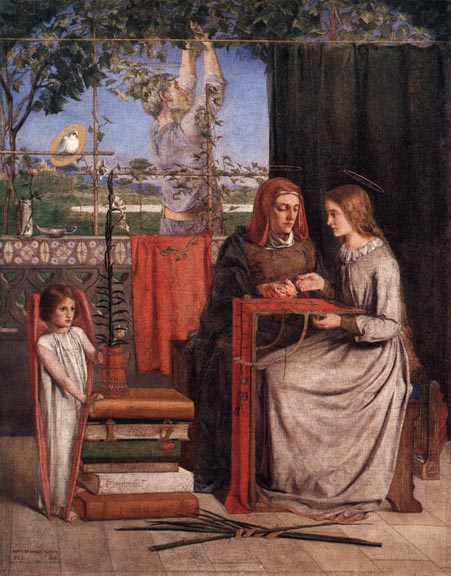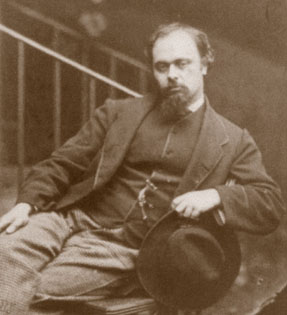|
MARY’S GIRLHOOD
I. This is that blessed Mary,
pre-elect, Strong in grave peace; in pity
circumspect.
So held she
through her girlhood; as it were II. These are the symbols. On that
cloth of red That Christ is not yet born. The
books --whose head The seven-thorn'd
brier and palm seven-leaved http://www.victorianweb.org/authors/dgr/1.html,
visited |
|
THE GIRLHOOD OF MARY VIRGIN
 The poem
I’m going to analyse was
written by Dante Gabriel Rossetti
referring to the painting with
the same name. Both sonnets
and the painting
have the same subject: the
Blessed Virgin in the house of
her parents, the representation of the future
Mother of Our Lord as occupied in embroidering a Lily, always under the
direction of St. Anne, her
mother. These two sonnets are inscribed beside each other on
the frame below “Mary’s Girlhood”,
and the purpose
of writing both sonnets was
to comment or interpret that
painting. (Rossettiarchive,
s40.rap)
The poem
I’m going to analyse was
written by Dante Gabriel Rossetti
referring to the painting with
the same name. Both sonnets
and the painting
have the same subject: the
Blessed Virgin in the house of
her parents, the representation of the future
Mother of Our Lord as occupied in embroidering a Lily, always under the
direction of St. Anne, her
mother. These two sonnets are inscribed beside each other on
the frame below “Mary’s Girlhood”,
and the purpose
of writing both sonnets was
to comment or interpret that
painting. (Rossettiarchive,
s40.rap)
The relationship between the painting “The
Girlhood of Mary Virgin” and
the poem “Mary’s Girlhood” is direct, both
are directly connected by the writer and
the topic that are dealt. And we can understand
some of the
symbolism of Dante Gabriel Rossetti’s painting by reading these two
sonnets, but not completely.
The metric characteristic of these sonnets
are the iambic pentameter and the rhyme is
abbaabbacdecde. The pair of sonnets
with this title have the
same rhyme scheme, although in the octave of the
second lines 6-7 are distinctly off-rhymes with lines
2-3. (Rossettiarchive, s40.rap)
In the first reading
of the poem
we can make an image in our
mind of how the painting could
be the representation of that poem.
We can see an image of
a normal girl who has an important written
fate, a fate which is probably
unknown by her.
The
first sonnet was written while Dante Gabriel Rossetti
was executing the painting (Rossettiarchive,
9-1848.s40.raw), and it is a verbal translation of the iconographical details (Rossettiarchive, s40.rap). The first eight lines “talk”
about the providential future of Mary Virgin, and then we can see the moment of
the illumination: “Till, one dawn at home, she woke in her white bed, and
had no fear at all,--yet wept till sunshine, and felt awed; because the fulness of the time was come.” (Verses 11 to 14).
The
second sonnet was written somewhat later, perhaps not until Dante Gabriel Rossetti had completed the painting (Rossettiarchive,
9-1848.s40.raw), and it is a literalization of its
Catholic symbology (Rossettiarchive,
s40.rap): the red cloth, the books, the lily, “The seven-thorn'd
brier and palm seven-leaved” (verse 23), etc. This sonnet is like an
explanation of the painting’s symbols, but it remarks the fact that the moment
of the Annunciation is closer: “She soon shall have achieved her perfect
purity: yea, God the Lord shall soon vouchsafe His Son to be her Son.”
(Verses 26 to 28).
The
picture itself attempts to give a faithful representation at two levels
simultaneously: at the level of the original narrative materials, from the
primitive history of Christianity, and at the level of the symbology
(Rossettiarchive, s40.rap). We can see on it a
snapshot of Mary as a child, seated with her mother St Anne and embroidering a
lily while her father St Joachim prunes a vine in the background (bbc.co.uk).
Dante Gabriel Rossetti’s mother, Frances Polidori Rossetti, sat for St.
Anne; his sister, Christina Rossetti, sat for the
Virgin; and “Old Williams”, employed by the Rossetti
family, sat for St. Joachim (Rossettiarchive,
s40.rap).
The
painting is rich in Christian symbolism: The lily, a flower symbolising Mary's
purity, is here being grown in a pot and carefully tended by a child angel.
This refers to the Angel Gabriel who will later announce to Mary that she is to
bear the Son of God (bbc.co.uk). There is a cross where St. Joachim is working;
the vine alludes to the True Vine; the red cloth draped at the centre signals
the robe of Christ’s Passion; the lamp signifies piety; the stack of books are color-coded to the virtues they represent, which names
appear on the book spines: Fortitudo (strength) , Temperentia (restraint), Prudentia
(prudence), Spes (hope), Fides (faith) and Caritas
(charity); the trellis-cross is twined with ivy as a symbol of “clinging
memory” (Rossettiarchive, s40.rap); and near Mary's
feet are the "seven-thorn"d briar and
the palm seven-leaved . . . her great sorrow and her great reward,"
(verses 23 and 24).
And
there is an element almost imperceptible, near St. Joachim there is a dove
covered by a circle of light representing the Holy Spirit, which seems to be
observing Mary to her posterior Annunciation. In the poem we can see as the
Holy Spirit is present: “Until the end be full, the
Holy One abides without.” (verses 25 and 26), it
is a crucial element in that part of the story of Virgin Mary’s life.
The
example of Christianity and, most especially, a medieval approach to the
Christian ethos was therefore used by Dante Gabriel Rossetti
as a model for a secular world and, even more particularly, for an aesthetic
procedure. The object was not at all to reinvigorate the cult or ideas of
Christianity, but to learn from that example the fundamental need for a
devotional approach to artistic and poetic work. (Rossettiarchive,
9-1848.s40.raw)
Painting
“The Girlhood of Mary Virgin”, Dante Gabriel Rossetti
didn’t feel the religiosity, what fascinates to him was not that the painting
could give his ideas to the public, it was that the painting itself could have
its own meanings. We can interpret the painting as we feel like, he has given
us two sonnets as a pattern to the better understanding of the picture, but the
last decision is in our mind, and that is what the author wanted from the very
beginning.
As
I said before, the poem is an explanation of the painting to highlight the
importance of typological symbolism that is in the painting because it may give
the impression to the “observer”, that the author wanted to express his
religiosity in the painting. But it is not like that, he does not want to
express religiosity, he wants to express him “through” religiosity. What he
wants from us is that we can find his ideas inside the painting and inside the
poem.
I
have found very peculiar that a little painting as “The Girlhood of Mary
Virgin” could give us so much information, there are a lot of elements
which give us a second or even a third meaning of what they are representing,
and to achieve that is difficult but Dante Gabriel Rosseti
had done it.
In
my opinion, the painting is very rich in symbolic components, and we had not
enough to interpret it just watching or reading the sonnets. There are a lot of
important elements that we could not consider as the author wants to. We can
see a stack of books next to an angel without knowing what their meaning is,
but we feel the necessity to know about those strange elements, we feel curious
about that, and later we can read that the books represent the virtues of Mary
Virgin.
All
this may happen with the other elements too, such as the red cloth, the lily,
the vine, the dove, etc. And that fact is what makes it interesting, we need
always to know more about all those elements to understand the entire picture,
to realise, at the end, what the author had wanted to tell us since his first
“brushstroke”.
BIBLIOGRAPHY
http://rpo.library.utronto.ca/poem/1778.html,
visited February 25, 2006
Margaret Frances (Sister St. Francis) Nims
All contents copyright © RPO Editors, Department of English, and University of Toronto Press
1994-2002
RPO is hosted by the University of
Toronto Libraries.
http://www.bbc.co.uk/bbcfour/paintingflowers/paintings/girlhood_mary_rossetti.shtml,
visited February 25, 2006
British Broadcasting Corporation © 2002-2005
From: http://www.rossettiarchive.org,
visited February 25, 2006
http://www.rossettiarchive.org/docs/s40.rap.html,
visited February 25, 2006
http://www.rossettiarchive.org/docs/9-1848.s40.raw.html,
visited February 25, 2006
Copyright © Jerome J. McGann 2000
Published and sponsored by the Institute for Advanced
Technology in the Humanities (IATH)
at the University of Virginia
From: http://www.victorianweb.org, visited
February 25, 2006
Funded in part by University Scholars Program,
National University of Singapore
http://www.victorianweb.org/painting/dgr/paintings/3.html,
visited
References:
Rossetti,
Dante Gabriel. The Poetical Works. 2vols. [Ed. William Michael Rossetti.]
Last modified 19 October 2004
http://www.victorianweb.org/authors/dgr/1.html,
visited
References:
Rossetti,
Dante Gabriel. The Poetical Works. 2vols. [Ed. William Michael Rossetti.]
Last modified 5 November 2003
http://www.victorianweb.org/painting/whh/replete/girlhood.html,
visited
by George P.
Landow
Last modified December 2001
http://www.victorianweb.org/authors/dgr/dgrseti13.html,
visited February 25, 2006
by Glenn
Everett, PhD
Last modified 1988
http://www.victorianweb.org/painting/prb/1.html,
visited
by George
P. Landow, Professor
of English and Art History,
Originally created: 1989; last updated: 1998
http://www.victorianweb.org/authors/dgr.moller12.html,
visited
by Kate Moller '05, History of Art 151, Pre-Raphaelites, Aesthetes, and Decadents,
Last modified 15 October 2004
